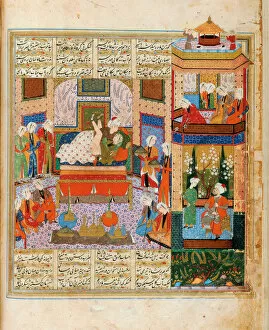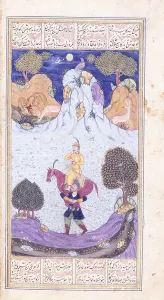Khamsa Collection
"Khamsa: A Quintessential Collection of Persian Art" Step into the enchanting world of Khamsa
All Professionally Made to Order for Quick Shipping
"Khamsa: A Quintessential Collection of Persian Art" Step into the enchanting world of Khamsa, a collection that showcases the rich tapestry of Persian art and literature. From intricate miniatures depicting historical events to beautifully illuminated manuscripts, this quintet is a treasure trove for art enthusiasts. One captivating piece from the Khamsa collection is "The Consummation of the Marriage Between Khusraw and Shirin. " Painted by an Iranian master, this miniature transports us to a time when love stories were immortalized on canvas. Another masterpiece within this collection is the Persian miniature portraying the epic battle between Alexander the Great and Darius. Created in the 16th century, it captures both bravery and chaos with remarkable detail. The Khamsa Standard from Qajar dynasty stands as an exquisite example of craftsmanship. Its unknown creator skillfully weaved together vibrant colors and intricate patterns, showcasing their mastery over textile arts during early 19th century Persia. Amir Khusrau Dedicates His Poem to Sultan Ala al-Din Khalji reveals not only poetic brilliance but also offers insight into royal patronage during medieval times. This page from Nizami's Khamsa exemplifies how literature was cherished by rulers throughout history. Delving deeper into Nizami's work, Safavid period folios mesmerize with pen-and-ink illustrations dating back to c. 1575. The delicate strokes bring characters to life while preserving ancient tales for generations to come. Bilqis enthroned adds another layer of mystique to this collection with its opaque watercolor depiction. This painting exudes regality as it portrays Queen Bilqis ruling her kingdom with grace and power. Amongst these treasures lies Kulliyat (Sa di Complete works), a testament to Saadi's literary genius adorned with ink, opaque watercolor, and gold detailing on paper. It serves as a reminder of the profound impact Persian poetry has had on world literature.














































